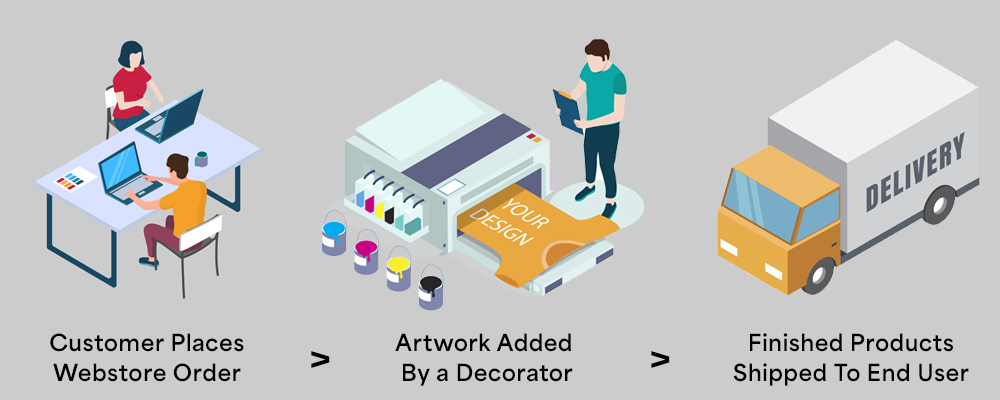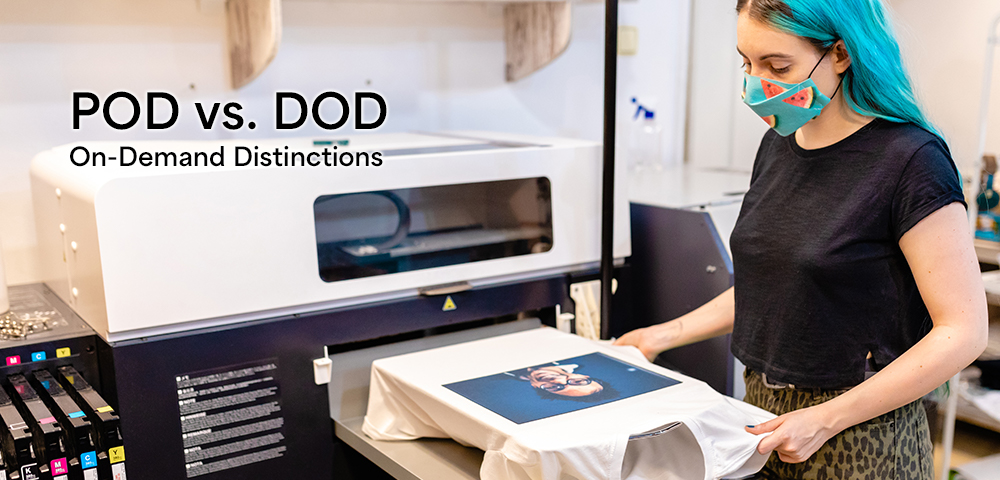Years ago, if you finally landed that major corporate account and their ongoing uniform needs, then you were also obligated to invest in inventory, so that as new employees are hired you could pick and ship their needs quickly. And then, alas…a logo change or disagreement over a transactional issue and these relationships could potentially dissolve, leaving someone (most likely you) dealing with the invested items.
Enter the On-Demand concept, which helps remove the commitment and better automate the workflow process. On-Demand is in opposition to investing in decorated inventory, instead offering items to be embellished and shipped as needed and can be separated into a couple different camps: Print On Demand (POD) and Decorate On Demand (DOD).
General On Demand Workflow

The system or platform technology automates most of these stages to allow process to flow smoothly and with minimal added touches needed, to keep cost low and avoid errors.
Print On Demand General Traits
- End user is ordering for personal use
- Product access is open to anyone
- Artwork/logo selection is broader, possibly even user-provided
When researching the term “Print on Demand” the Wikipedia results yielded insights about this concept relating to the book printing industry, meaning when books are printed as needed versus someone committing to buying and printing thousands. For many years Amazon has offered books on an on-demand basis – they don’t sit on the shelves, they get printed and bound at a local Amazon warehouse only after someone has ordered a copy. Direct to Garment (DTG) printing uses similar technology systems that help automate workflow for digitally printing apparel.
I’m not sure who was first, but as the rise of DTG printing increased and smarter software evolved, POD companies such as DTG2GO, Printful, Printify and even Amazon have popped up over the last ten years. What they all have in common are roots in using DTG as the foundation of their decoration option. With barcode scanning efficiency in place and no need for setting up and washing out screens, DTG could work faster for one-off designs on garments. Eventually some would add in transfers, sublimation and maybe even some hard goods, but the bulk of this category is centered around DTG. The other thing these companies all have in common is a focus around B2C, selling and shipping direct to an end user their personalized items, not as part of a company uniform.
Decorate On Demand General Traits
- End user is ordering for business use
- Product access is often private
- Artwork/logos are more limited and specific to the company
The three years of the pandemic saw massive sales growth for all online decorated apparel, including POD. There has been a rebound effect heading into 2023, as consumers enjoy shopping in-person for apparel and customization. The one exception to this is the surge of business-related use-cases that need uniforms and merch. Now the traditional investments in inventory are no longer needed, as the flow foundation that DTG-based POD company models established, are fueling more robust Decorate on Demand (DOD) systems.
One of the early service providers, F.A.S.T Platform, uses their technology to help manage the work order details beginning with the broker/seller and organizes it to be production-ready for the decorators. They have a network of contract decorators who consume the work order data, decorate and ship out, creating an ecosystem that is efficient and effective. Contrary to DTG-only services, this system also works with screen printing, embroidery, transfers and more. This also often connects with business-based webstores selling on an as-needed basis.
Throughout this year we’ve seen new systems emerging and jumping into the DOD system solution space. Their market differentiation is maintaining that focus on selling the service to established industry members, typically Promotional Product Distributors (PPDs) and the connection to business-based webstore programs. Examples include Fulfill Engine, Splashbrands, and Single Serve Merch. As things progress, new entities will continue to add to this list and our team will remain dialed-in as a resource to help with advice and counsel.
If you want to know more about DOD and all things industry tech, please reach out to techsolutions@sanmar.com to schedule a Tech Talk. We’re happy to help!
